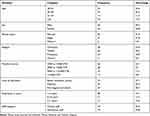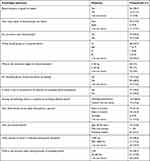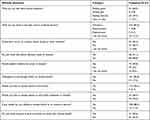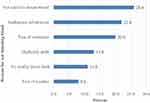Back to Journals » Journal of Blood Medicine » Volume 12
Blood Donation and Associated Factors Among Employees Working at Negele Arsi General Hospital and Medical College, Southeast Ethiopia: A Cross-sectional Study
Authors Nigussie Yirgu A, Hussien Mohammed K, Degno Diriba S , Kumbi Babso A, Abdo AA
Received 16 January 2021
Accepted for publication 20 May 2021
Published 15 June 2021 Volume 2021:12 Pages 475—482
DOI https://doi.org/10.2147/JBM.S301826
Checked for plagiarism Yes
Review by Single anonymous peer review
Peer reviewer comments 4
Editor who approved publication: Dr Martin H Bluth
Ashebir Nigussie Yirgu,1 Kassim Hussien Mohammed,2 Sisay Degno Diriba,3 Abdella Kumbi Babso,4 Abdella Amano Abdo5
1Negele Arsi General Hospital and Medical College, Department of Anesthesia, Negele Arsi, Ethiopia; 2Department of Sociology, Negele Arsi General Hospital and Medical College, Negele Arsi, Ethiopia; 3MaddaWalabu University, Shashemene Campus, School of Health Science, Department of Public Health, Shashemene, Ethiopia; 4Negele Arsi General Hospital and Medical College, Department of Gynecology and Obstetrics, Negele Arsi, Ethiopia; 5Hawassa University, College of Medicine and Health Science, School of Public Health, Hawassa, Ethiopia
Correspondence: Ashebir Nigussie Yirgu Email [email protected]
Background: Blood is a specialized body fluid in humans. Securing voluntary, nonpaid blood donation is an important national goal to prevent blood shortages. The donated blood plays a big role during surgery, accidents, delivery, bleeding cases, and the like. Currently, in many developing and developed countries, the blood supply is critically insufficient. Hence, the aim of this study was to assess the practice of blood donation and associated factors among employees (clinical and nonclinical) at Negele Arsi General Hospital and Medical College.
Methods: A facility-based cross-sectional study was conducted from August 1 to 20, 2020. Self-administered and interview-administered questionnaires were used to collect the data. A stratified sampling method was employed to select 122 participants. Data were entered into EpiData 3.1 software and the analysis was done using SPSS version 25. Bivariable and multivariable binary logistic regression analysis with 95%CI was carried out.
Results: Among 122 employees who participated in the study, 39% have ever donated blood. Clinical staff were eight times more likely to donate blood compared to nonclinical staff (AOR=7.81, 95%CI: 2.15– 28.39). Those who had one to five years work experience were 85% (AOR=0.15, 95% CI:0.03-0.74) less likely to donate blood compared to > 11 years of work experience.Those with inadequate knowledge were 71.0% (AOR=0.29, 95%CI: 0.09– 0.89) less likely to donate blood compared to those with adequate knowledge. Those with an unfavorable attitude were 68.0% (AOR=0.32, 95%CI: 0.11– 0.92) less likely to donate blood compared to those with a favorable attitude.
Conclusion: Generally, blood donation practice was low in the study area. The professional category, work experience, knowledge, and attitude were significantly associated with the practice of blood donation. Therefore, a blood donation campaign should be prepared to strengthen the practice.
Keywords: blood donation, practice, associated factors, employees, hospital, Negele Arsi
Introduction
Blood is one of the most valuable donations. Blood transfusion is essential and life-saving support within the health-care system, which saves millions of lives each year. The need for equitable and timely access to safe blood is universal but is not available to many patients requiring transfusion as part of their clinical management.1
Donated blood is very important for pregnant women during bleeding and childbirth, in the young age group suffering from severe anemia secondary to malaria and malnutrition, and in case of trauma, emergencies, accidents, and advanced surgical procedures like cardiovascular surgery and transplantation.2
World Health Organization (WHO) recommends that; by 2020 countries achieve 100% anonymous nonpaid voluntary blood donation, focusing on young people. This is because young people are healthy, active, self-motivated, and open, and constitute a greater proportion of the population.3
According to the WHO report of 2014, globally there are around a total of 10,000 blood centers. Globally, in 2013 around 108 million blood donations were collected. However, nearly half of these were collected in high-income countries.4
In developing countries, donors usually give blood when family or friends want a transfusion. However, in the developed countries, most blood donors are voluntary nonpaid donors who donate blood for their population.5
To ensure safe, adequate, and sustainable blood supplies all over the country, health workers have a significant role in different ways. Even if health workers are too low in numbers, they are vital to mobilize the community towards blood donation.
All clinical and nonclinical hospital employees are expected to be more aware than the general population and take the lead to create awareness on blood donation. Therefore, the aim of this study was to assess the practice and associated factors of blood donation among employees at Negele Arsi General Hospital and Medical College (NAGHMC), Ethiopia.
Materials and Methods
Study Setting
Negele Arsi General Hospital and Medical College is located in Oromia regional state in west Arsi zone, Negele Arsi town, 250km from Addis Ababa, the capital city of Ethiopia. This is the only private hospital in the town. The facility provides medical education training in addition to medical services. This hospital provides service for different clients who comes from Bale, East Arsi, Guji, West Arsi, and other zones of Oromia regional state. The hospital provides service as a general hospital and is open 24 hours for emergency services. It has around 162 staff working in different fields: 64 clinical staff (9 physicians, 35 nurses, 8 laboratories, 6 pharmacists, 3 anesthetists, and 3 radiology technicians) and 98 nonclinical staff.
Study Design and Period
This was an institution-based cross-sectional study design and was conducted at NAGHMC from August 1 to 20, 2020.
Population
The study population were all employees providing services at NAGHMC. Those employees on annual leave were excluded from the study.
Sample Size Determination and Sampling Procedure
The sample size was determined using a single proportion formula based on the prevalence from the previous study conducted in Debre Markos town6 using 56.6% for knowledge level, using 95% confidence interval level (Zα/2=1.96) and margin of error to be 5% (d=0.05). So, n=(1.96)2×0.565×(1–0.565)/(0.05)2=378.
Since the source population (162) was less than 10,000 (N<10,000), a sample size correction formula was applied and add a 10% nonresponse rate, then the final sample size was determined to be 125. A stratified sampling technique was used to select the study subject. Study participants sample was stratified as clinical and nonclinical employees and then simple random sampling was used based on proportional allocation to select study participants from each group.
Data Collection Technique and Procedure
The data was collected using self-administered and interviewer-administered questionnaires. The questionnaire included sociodemographic characteristics and also questions on knowledge, attitude, and practice toward blood donation. Knowledge of blood donors was assessed by summing up the response of each individual among 12 questions. Those who scored mean and less than mean value were categorized as having inadequate knowledge and those who scored above mean were categorized as having adequate knowledge. Also, attitude toward blood donors was assessed from 10 questions. Those who responded below mean were considered as having unfavorable attitude and those scored mean and above as having a favorable attitude. Also, the practice of study participants toward blood donation was assessed through the experience of blood donation, reasons for donating, and not donating blood.
Data Quality Assurance
The quality of data was assured by proper designing and pretesting on 5% of the questionnaires. The training was given to data collectors as well as a supervisor by the principal investigator. During the data collection period, all completed questionnaires were reviewed and cross-checked for completeness every day.
Data Processing and Analyzing
The data were cleaned and checked for completeness and entered into EpiData 3.1. SPSS version 25 was used to analyze data. Data was presented using text, tables, figures, and summary measures such as mean, standard deviation, and proportion. Bivariable and multivariable binary logistic regression model were used to identify factors associated with practice of blood donation. Odds ratio (OR) and 95% confidence interval (CI) were used to measure the strength of association between dependent and independent variables. In multivariable logistic regression P-value ≤0.05 was considered for statistical significance.
Ethical Consideration
The study was conducted in accordance to the Declaration of Helsinki. Ethical clearance was obtained from the Ethical Review Committee of NAGHMC. Also, verbal consent was obtained from all study participants, after they had been informed about the objective of the study. Confidentiality of the participants’ information was kept throughout the research processes.
Results
Sociodemographic Characteristic of Respondents
A total of 122 employees responded to the questionnaires, with a response rate of 97.6%. Among the participants, 40.2% were clinical staff and 59.8% were nonclinical staff. More than two in five (42.6%) were within the age range of 18–25 years, and 62 (50.8%) of the participants were females. More than half (54.1%) of the study participants had a monthly income of between 1000 and 3000 Ethiopian Birr (ETB). Nearly three-quarters (72.1%) of the participants had work experience ofone to five years (Table 1).
 |
Table 1 Distribution of Sociodemographic Characteristics of Employees in Negele Arsi General Hospital and Medical College, August 2020, Negele Arsi, Southeast Ethiopia (N=122) |
Knowledge Level of Study Participants About Blood Donation
Out of the total study participants, 83 (68%) had adequate knowledge whereas 39 (32%) had inadequate knowledge about blood donation. The majority, 96 (78.7%) of the study participants knew that blood donation is good for health and 41% said the minimum weight for donation is ≥45 kg. Most of the respondents, 97 (79.5%) had adequate knowledge about the risk of infection transmission during a blood transfusion (Table 2).
 |
Table 2 Level of Knowledge on Blood Donation Among Employees in Negele Arsi General Hospital and Medical College, August 2020, Negele Arsi, Southeast Ethiopia (N=122) |
The Attitude of Study Participants Toward Blood Donation
Two-thirds (67.2%) of the respondents had a favorable attitude toward blood donation. Among respondents, 81 (66.5%) feel that blood donation was good and 102 (83.6%) of the study participants think that voluntary blood donation was the best source of blood (Table 3).
 |
Table 3 Attitude Toward Blood Donation in Employees at Negele Arsi General Hospital and Medical College, August 2020, Negele Arsi, Southeast Ethiopia (N=122) |
Blood Donation Practice of Study Participants
Among the participants, 48 (39.3%), 95%CI: 30.97–48.22 had ever donated blood. Of the total respondents, 26 (21.3%) of donors had donated blood two to four times. Among donors, nearly one-quarter (23.0%) donated last year. After donating blood, 35 (28.7%) reported that they feel happy, five (4.1%) feel fatigued, and eight (6.6%) feel mixed. More than one out of five (22.0%) of participants mentioned lack of adequate information about blood donation as a reason for not donating the blood (Figure 1).
 |
Figure 1 Reasons for not donating blood among employees at Negele Arsi General Hospital and Medical College, August 2020, Negele Arsi, Southeast Ethiopia. |
Factors Associated with Blood Donation Practice Among Employees of NAGHMC
Those variables that had a P-value ≤0.25 in binary logistic regression were transferred to multivariable logistic regression. Among the variables, category of the profession, one to five-years' work experience, knowledge level, and attitude of the study participants were significantly associated with the practice of blood donation in multivariable logistic regression. Accordingly, clinical staff were eight times more likely to donate blood than nonclinical staff (AOR=7.81, 95%CI: 2.15–28.39). Those who had one to five years of experience were 85.0% less likely to donate blood compared to >11 years’ work experience (AOR=0.15, 95%CI: 0.03–0.74). Those with inadequate knowledge were 71.0% less likely to donate blood compared to those with adequate knowledge (AOR=0.29, 95%CI: 0.09–0.89). Participants who have an unfavorable attitude toward blood donation were 68.0% less likely to donate blood compared to those with a favorable attitude. (AOR=0.32, 95%CI: 0.11–0.92) (Table 4).
 |
Table 4 Factors Associated with Practice on Blood Donation Among Employees in Negele Arsi General Hospital and Medical College, Ethiopia, 2020 |
Discussion
In our study, among the total study participants, the practice of employees toward blood donation was 39.3%. The variables significantly associated with the practice of blood donation were the category of the professions, between one and five years’ experience, knowledge, and attitude of the respondents.
In this study, concerning practice towards blood donation, 39.3% had ever donated blood and this finding is supported by the study conducted on the physician of University of Benin Teaching Hospital in Nigeria (41.4%)7 and study among health professionals in Addis Ababa Tikur Anbessa specialized hospital in which blood donation practice was 38.3%.8 The finding of this study also supported by a study conducted in the University of Gondar Hospital (33.2%),9 and Tigray regional hospital (47.8%)10 of the health professionals practiced blood donation.
In this study, years of experience had a significant association with blood donation practice. Those employees who had work experience between one and five years were less likely to donate blood compared to more than 10 years’ experience. A similar finding was reported from a study conducted at the University of Gondar.9 This might be because those who had less work experience may not have adequate exposure to the necessity of blood in their work environment.
Category of the profession is also another factor associated with blood donation. Clinical workers were more likely donate blood compared to nonclinical workers. This finding was in line with a study conducted in ALERT Hospital, Addis Ababa11 in which health professionals were more likely donate blood compared to non-health professionals. This could be due to the fact that health professionals had good awareness about the importance of blood dation and closely work with individuals in need of blood.
Those study participants with inadequate knowledge of blood donation were less likely to donate blood compared to those with adequate knowledge. This finding was in line with a study conducted in a different part of Ethiopia9,10,12 where the participants' knowledge showed significant association with blood donation. This can be explained by the fact that those who had inadequate knowledge about blood donation could not understand the benefit of blood donation for those in need.
In the current study, the attitude of the respondents was significantly associated with blood donation practice. Those respondents with unfavorable attitudes were less likely to donate blood compared to those with a favorable attitude. This finding is supported by the study conducted in the University of Gondar hospital,9 Tigray regional state hospitals,10 and ALERT Hospital11 where the attitude of health professionals had a significant association with the practice of blood donation. This could be explained by having a good attitude can motivate individuals to donate blood to save others’ lives.
Conclusions
Overall, in Negele Arsi General Hospital and Medical College practice of employees towards blood donation was low. Year of experience, category of professions, knowledge, and attitude of employees were significantly associated with the practice of blood donation. Therefore, staff updating training to empower their knowledge are important. The hospital has to prepare a blood donation campaign and a need for an active education program.
Abbreviation
AOR, adjusted odds ratio; CI, confidence interval; COR, crude odds ratio; KAP, knowledge, attitude, and practice; NAGHMC, Negele Arsi General Hospital and Medical College.
Data Sharing Statement
The data sets used and/or analyzed during this study are available from the corresponding author on reasonable request.
Acknowledgments
Our heartfelt thanks go to all study participants and data collectors who participated in the study. The authors would like to thank NAGHMC for the provision of facilities to conduct the study.
Author Contributions
All authors made a momentous involvement to the work reported, that is in the conception, study design, execution, acquisition of data, analysis and interpretation, or in all these areas; participate in drafting and revising of the article; all reviewed and agreed on all version during the process of publication; all agreed on the journal type to which the article has been submitted; and agreed to take responsibility for the contents of the article.
Funding
There is no funding to report.
Disclosure
The authors report no conflicts of interest in this work.
References
1. World Health Organization. Universal access to safe blood transfusion; 2008.
2. Loua A, Nikiema JB, Sougou A, Kasilo OJM. Transfusion in the WHO African Region. Transfus Clin Biol. 2019;26(3):155–159. doi:10.1016/j.tracli.2019.06.191
3. WHO Guidelines Approved by the Guidelines Review Committee. In towards 100% voluntary blood donation: a global framework for action. Geneva: World Health Organization; 2010.
4. Roberts N, James S, Delaney M, Fitzmaurice C. The global need and availability of blood products: a modelling study. Lancet Haematol. 2019;6(12):e606–e615. doi:10.1016/s2352-3026(19)30200-5
5. Salaudeen AG, Odeh E. Knowledge and behavior towards voluntary blood donation among students of a tertiary institution in Nigeria. Niger J Clin Pract. 2011;14(3):303–307. doi:10.4103/1119-3077.86773
6. Jemberu YA, Esmael A, Ahmed KY. Knowledge, attitude and practice towards blood donation and associated factors among adults in Debre Markos town, Northwest Ethiopia. BMC Hematol. 2016;16(1):23. doi:10.1186/s12878-016-0062-8
7. Nwogoh B, Aigberadion U, Nwannadi AI. Knowledge, attitude, and practice of voluntary blood donation among healthcare workers at the University of Benin Teaching Hospital, Benin City, Nigeria. J Blood Transfus. 2013;797830. doi:10.1155/2013/797830
8. Teklu SJ. College of Health Sciences, Addis Ababa University. Knowledge, attitude, practice and associated factors of blood donation among health care workers in Tikur Anbessa specialized hospital. Addis Ababa, Ethiopia; 2015.
9. Arage G, Ibrahim S, Adimasu E. Blood donation practice and its associated factors among health professionals of University of Gondar Hospital, Northwest Ethiopia: a cross sectional study. BMC Res Notes. 2017;10(1):294. doi:10.1186/s13104-017-2618-5
10. Tadesse T, Berhane T, Abraha TH, et al. Blood donation practice and associated factors among health professionals in Tigray regional state public hospitals, northern Ethiopia. BMC Res Notes. 2018;11(1):677. doi:10.1186/s13104-018-3786-7
11. Teferi MY, Woldesenbet SG, Feleke SA, Abebe EH, Adane HT, Alemayehu CM. Assessment of the level and factors associated with knowledge, attitude and practice of blood donation among medical and paramedical personnel in ALERT Hospital, Ethiopia. J Public Health Res. 2021;10(1):1860. doi:10.4081/jphr.2021.1860
12. Bantayehu D, Affairs H. Knowledge, attitude, and practice of voluntary blood donation and associated factors among health care providers in Addis Ababa health facilities. Ethiopia; 2015.
 © 2021 The Author(s). This work is published and licensed by Dove Medical Press Limited. The full terms of this license are available at https://www.dovepress.com/terms.php and incorporate the Creative Commons Attribution - Non Commercial (unported, v3.0) License.
By accessing the work you hereby accept the Terms. Non-commercial uses of the work are permitted without any further permission from Dove Medical Press Limited, provided the work is properly attributed. For permission for commercial use of this work, please see paragraphs 4.2 and 5 of our Terms.
© 2021 The Author(s). This work is published and licensed by Dove Medical Press Limited. The full terms of this license are available at https://www.dovepress.com/terms.php and incorporate the Creative Commons Attribution - Non Commercial (unported, v3.0) License.
By accessing the work you hereby accept the Terms. Non-commercial uses of the work are permitted without any further permission from Dove Medical Press Limited, provided the work is properly attributed. For permission for commercial use of this work, please see paragraphs 4.2 and 5 of our Terms.
